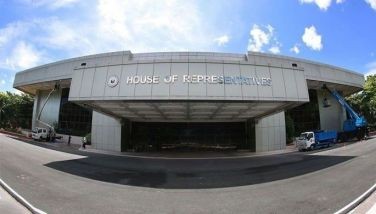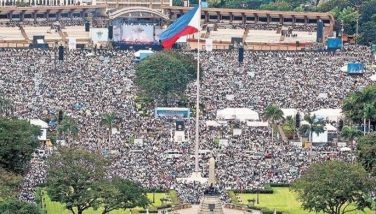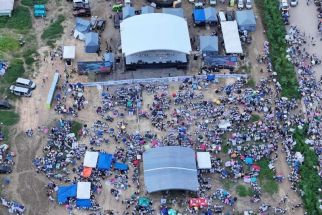Where do we go from here?

Another flood, another test for Filipino resiliency and soon enough the headlines fade from memory and we go back to our old ways. Floods are not new to the Philippine scene. I grew up expecting floods every rainy season in the Manila district of Paco. As a kid, I enjoyed playing in the flood waters. Strangely enough, I only learned about leptospirosis when I was in my 40s.
We coped with the annual floods as best we can. Our refrigerator was at the second floor of our house even if the dining room and kitchen were downstairs. Our washing machine sat on a concrete slab that’s more than two feet above the floor. When the typhoon signal was raised, we stocked up on canned food and considered ourselves lucky we lived close to a bakery known for their hot pan de sal.
But through typhoon Yoling and other monster typhoons in my younger days, I don’t remember Mother Nature in tantrums as bad as what we are seeing these days. Maybe the mountains around Metro Manila were not as devastated and denuded as is the case now. Maybe the volume of garbage clogging our esteros was a fraction of what is there now. Maybe it’s climate change in action.
Government response to the floods then and now are Band-aid measures, lacking in long-term impact. I remember how government responded to flooding in our street by raising the street level a meter or so. That only brought the floods to our homes faster and solved nothing for residents.
Then as now, government pays lip service to cleaning and modernizing the drainage system which includes the esteros. We didn’t have a Gina Lopez at that time to clean up the Estero de Paco so the work didn’t get done.
If you checked back issues of newspapers, you will find out we have been talking about the evils of deforestation over 50 years ago. But things just got worse so that now, even normal rainfall would quickly cascade down the foothills of the Sierra Madre mountains to Marikina River and flood Metro Manila.
It seems the problem had become unsolvable. Metro Manila is now home to 14 or maybe as many as 20 million souls in a land area a large part of which was a flood plain when Miguel Lopez de Legaspi, the Spanish conquistador, won his battle with local chieftains and made Manila the seat of his government.
The Americans came and Daniel Burnham made a remarkable city plan. But that Burnham master plan was set aside after the Americans and the Japanese devastated the city during WW2. We rebuilt Metro Manila the way we developed the jeepney… in a haphazard, make-do manner that’s difficult to unravel decades after.
Kelvin Rodolfo, an eminent Filipino geologist, gave a good perspective of what happened last week. Here is Dr. Rodolfo’s reaction to a New York Times account of last week’s floods:
“Just finished reading 35 comments...this abnormal rainfall event may be blamed on climate change induced by global warming, but sea level rise from global warming is not to blame. Far too few people know that a major cause of Metro Manila’s worsening floods is that the land there is sinking several inches a year -- more than ten times faster than sea level rise.
“This is because the Manila population is exploding, and is pumping out groundwater much faster than nature can replace it. A fellow Filipino scientist and I published about this in Disasters, an international journal in 2006.
“Meanwhile, pious Catholic politicians are saying that God is punishing the Philippines with the floods because its congress is considering a Reproductive Health bill. How very sad...”
The way things look… things will not get better years from now. We need a government and a citizenry working together to do what we can to at least mitigate this annual deluge. There are enough Filipinos with technical know how to deal with this problem. With a PPP approach there is also enough money to finance such plans. What is lacking is political will to do what must be done.
For starters, let us face the fact that forest denudation is the immediate cause of flooding that happens after a strong rainfall. We must reforest!
An all out effort to reforest the headwaters of the Marikina River in the foothills of the Sierra Madre should be a top priority. No amount of flood control infrastructure will work if all that water from even a moderate rainfall will quickly cascade down the mountains into our homes.
That reforestation challenge sounds like mission impossible but it isn’t. When Gina Lopez first took the challenge of replanting the La Mesa Dam watershed area, we flew around the site in a helicopter. I saw the vast devastation and thought it was too big a task to take on. Gina thought otherwise. She was right.
La Mesa Watershed is 2,700 hectares, 700 hectares of which is the reservoir and 2,000 hectares is the surrounding forest. Gina likes to point out this forest is the last remaining one of its size in Metro Manila. La Mesa Watershed is vital to the city, not only because it is a primary source of drinking water, but also because its forest absorbs our carbon dioxide emissions and acts as the lungs of Metro Manila, providing us with clean air.
Due to lack of funds, illegal settling, poaching and logging, La Mesa Watershed came into ruin. The total area that needed reforestation was 1,500 hectares. Gina delivered on the La Mesa reforestation but it was not easy. She lost a few men in the process, possibly killed by the squatters and kaingeros who didn’t want their lifestyle and livelihood disturbed. Good for us Gina is not afraid to take on daunting problems that everyone says can’t be done.
I don’t know if she still has time to spearhead a reforestation program for the headwaters of Marikina River because she has her hands full with the clean up of the esteros and Pasig River as well as a drive to keep mining out of Palawan. There must be another one like her with nerves of steel who can do an even more important reforestation project with immediate impact on Metro Manila every time the rains come.
Reforestation aside, we need to get the Metro Manila mayors working together too on a number of projects to clear esteros and other drainage channels of garbage and illegal construction. Communities can help as well.
The Chinatown community for instance, should not wait for the city government to do something about the esteros in their district. I was walking some foreign guests in Chinatown and was embarrassed and horrified to see how badly polluted the esteros there are.
The Chinoys there know very well they cannot depend on government for much of what they need. That’s why they have their own fire brigades. Can’t they add the estero clean up project as well?
Let the feuding officials and members of the FFCCC and various FilChi Business Clubs work together for this very visible and very worthwhile endeavor. Once the esteros are cleaned up, they can even revive the old creekside eating places as tourist attractions. They don’t have to reinvent the wheel because I am sure Gina would share what she has learned in cleaning Estero de Paco.
The various mayors can also task their building officials to look for vanished esteros. I understand even the UST campus sits on an old estero, which explains the flood there from heaven knows when. Maybe the Dominican fathers can return the creek or find a way to mitigate the impact of losing that estero on rainy season flooding in that area.
Well… we can’t do much about global warming as a country with our rather small carbon footprint. But that doesn’t mean there is nothing we can do. Every little bit counts. How we deal with garbage, for instance. The choices we make as consumers also have an impact on such things that can cause calamities.
For now, it would be great if P-Noy called a meeting of the 17 Metro Manila mayors, as he announced he plans to, and ask them how they can all work together not just to respond to floods and other disasters but to prevent these from happening altogether.
We vowed not to forget Ondoy. But we did soon enough and Sendong came and we forgot again so when the habagat disrupted our lives, we looked pretty stupid already. I know it is said that Pinoys have short memories but this is too much.
Thought for the day
The best time to plant a tree is 20 years ago, the next best time is right now!
Boo Chanco’s e-mail address is bchanco@gmail.com. Follow him on Twitter @boochanco
- Latest
- Trending
































